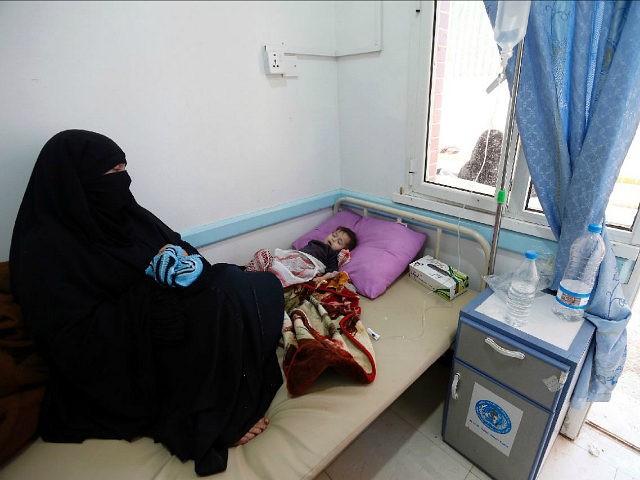The humanitarian situation in the Yemeni provinces of Hudaydah and Taiz is deteriorating further, driving families to live out “in the open in harsh conditions” and resort to “begging and child labor” to survive, reports the United Nations as a cholera epidemic grips the war-ravaged nation.
Reuters notes:
Spilling into the hallways of crowded Yemeni hospitals [including in Taiz and Hudaydah], children writhe in pain from cholera. Displaced villagers roam baking hot plains and barren mountains to evade warring militias.
The escalating outbreak of disease and displacement of tens of thousands by recent fighting has inflamed one of the world’s worst humanitarian crises, pushing Yemen’s war-pummeled society ever nearer to collapse.
According to the Geneva-based International Committee of the Red Cross (ICRC), cholera, a diarrheal disease spread by food or water tainted with human feces, has already killed an estimated 180 people in less than a month.
Citing the U.N., Reuters estimates that “in Yemen a child under the age of five dies every 10 minutes from preventable causes, two million people have fled fighting near their homes and only half of hospitals have staff and supplies to function normally.”
Although the Yemeni capital Sanaa has been the region worst hit by cholera, followed by the surrounding province of Amanat al-Semah, cases have also surfaced in other major cities including Hudaydah, Taiz, and Aden, the World Health Organization (WHO) has shown.
Taiz and Hudaydah are the capitals of the provinces of the same name.
William Spindler, a spokesperson for the U.N. Refugee Agency (UNHCR), told reporters on Tuesday:
In [the] Mokha [district of Taiz province], UNHCR teams observed worsening conditions for both those displaced by conflict and the local communities hosting them. Many people are living out in the open in harsh conditions and without adequate shelter, protection and material assistance.
In Hudaydah, UNHCR field teams also observed a huge spike in humanitarian needs. Displaced people are now living on the streets with some taking shelter on pavements, and others most vulnerable including female and child-headed households turning to negative coping strategies to enable their survival such as through begging and child labour, which is now rampant across the governorate.
UNHCR has managed to secure the distribution of aid to conflict-stricken Mokha for the third time this year.
The latest UNHCR aid distribution in Mokha will cover more than 6,200 people with emergency assistance, adding to the 69,857 already reached since the start of this year. Another 17,745 people have been reached in Hudaydah in the same period.
“Hostilities in the Red Sea governorate of Taizz, south of Al Hudaydah, have displaced almost 50,000 people since the start of 2017. This is in addition to the three million who have been uprooted since the beginning of the conflict in Yemen, of whom two million remain displaced and one million have provisionally returned home to precarious conditions,” pointed out the U.N. agency spokesman.
“Taizz governorate has been a flashpoint in the conflict, generating 27 percent of internally displaced people in Yemen, and also hosting another 303,672 displaced people. Many who have attempted to flee hostilities in Taizz have been displaced elsewhere across the governorate,” he added.
Despite the deteriorating conditions in Yemen, “UNHCR’s response to the humanitarian crisis in Yemen is only funded by less than a quarter to date,” noted Spindler.
Yemen is already one of the poorest nations in the Middle East.

COMMENTS
Please let us know if you're having issues with commenting.